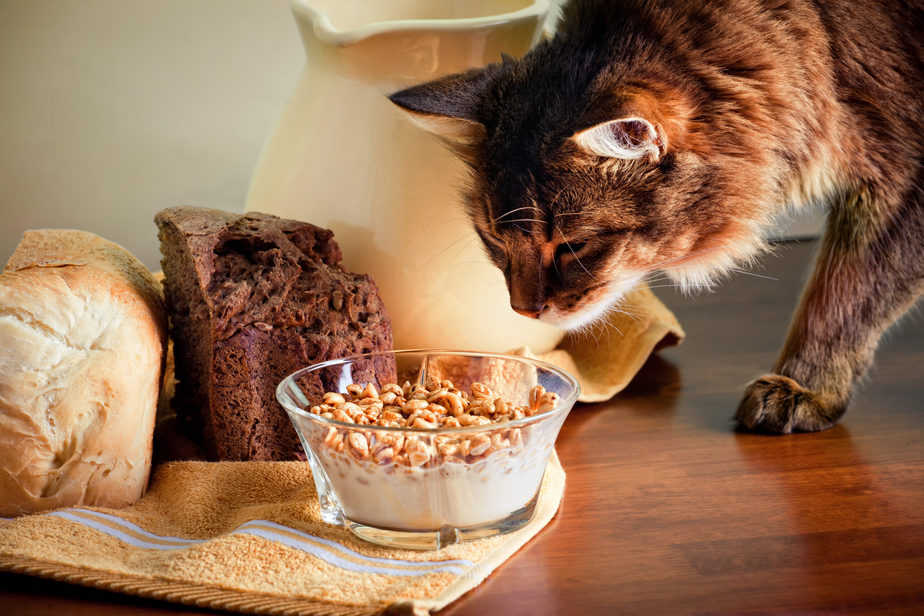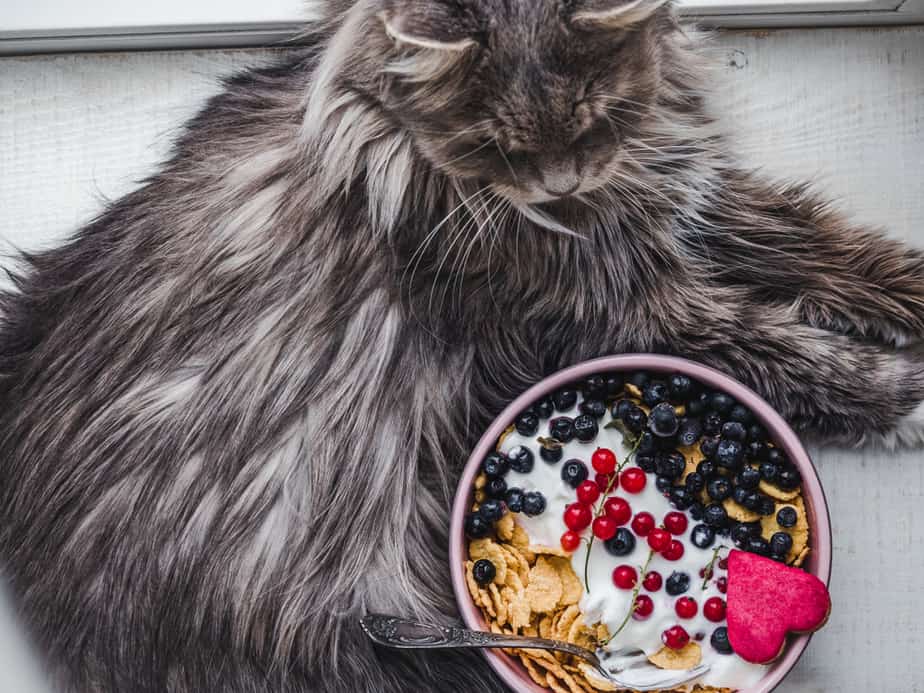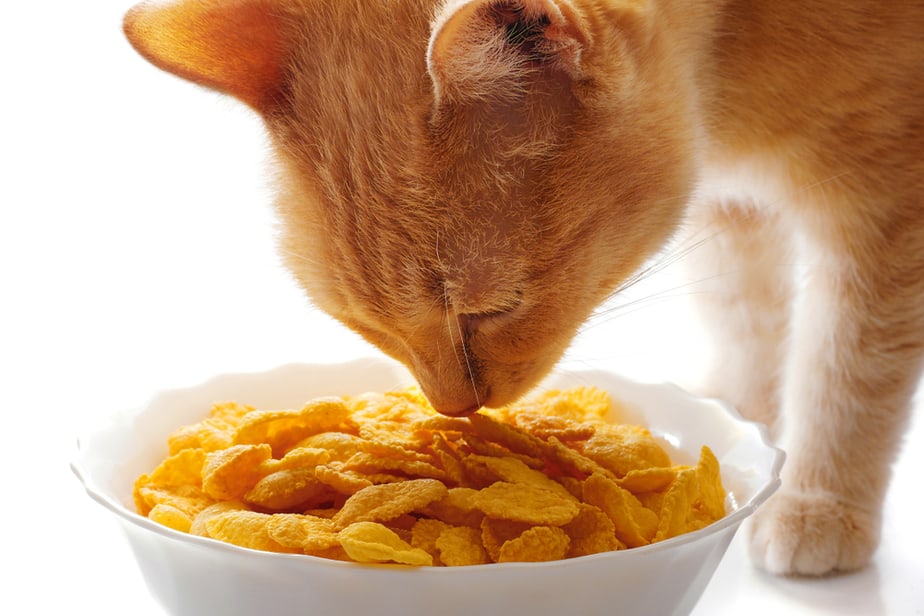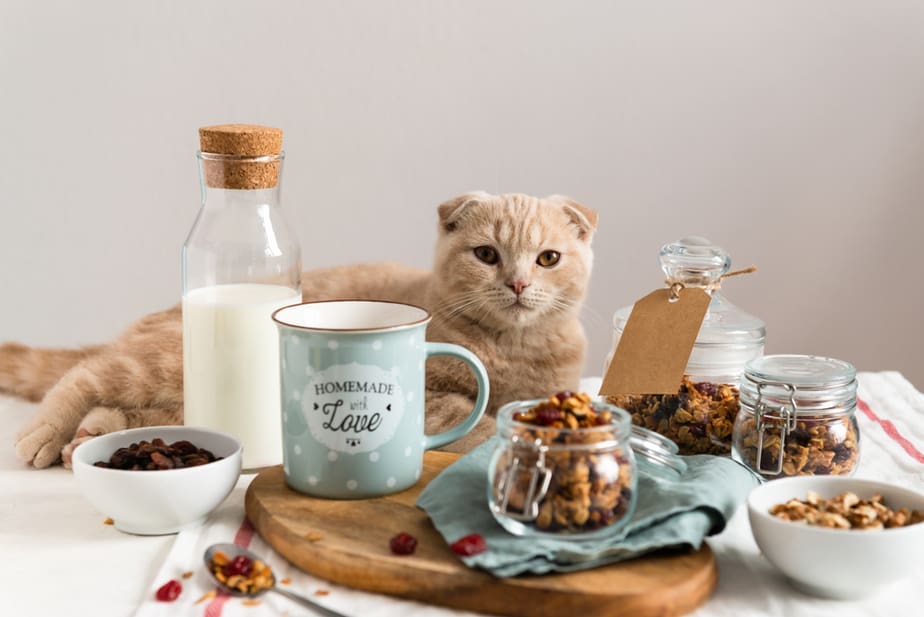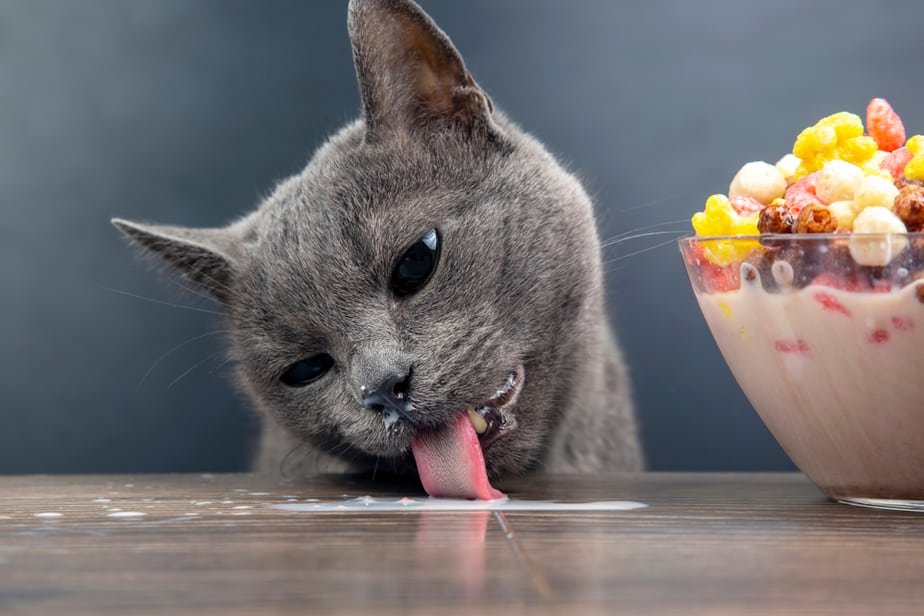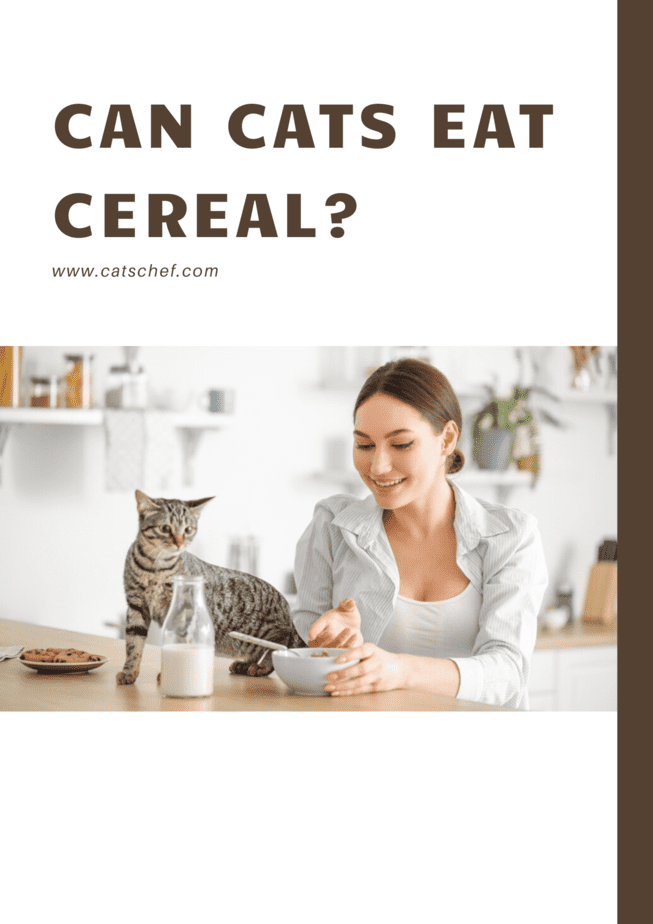📖 Table of Content:
The debate about whether cats can eat cereal has been tickling our curiosity. Cereals are quick and easy to prepare. This breakfast can come in handy when you’re in a rush. Late for work or school? Pour your cereal of choice into a bowl and add milk. Or vice versa – we know it’s an eternal debate whether milk goes before cereals.
Cats can eat cereal, and you probably googled it when your furball already gulped down some of it. The real question is should they eat cereal?
Debunking the myth about milk
Oftentimes people will offer milk to their cats. We’ve seen cats drinking milk in advertisements, cartoons, even in children’s books. Because of that influence, it’s become a common misconception that cats drink milk.
However, this isn’t the case. Yes, cats can drink milk and even cereal milk. But that doesn’t mean it’s the right choice for your feline.
You would think milk is acceptable as a part of your cat’s diet. Well, to some extent, yes. Humans use milk almost every day and it’s proven to be beneficial to their health.
Cow’s milk is the most widespread type of milk on the market and is put to use in various forms. It’s an ingredient in making other foods and generally, a drink on its own.
The amount of protein, fat, carbohydrates, as well as vitamins, is what welcomes milk in humans’ diet. This nutrient-dense food is probably most famous for its vitamin D and calcium content.
When we were younger, we were always coaxed into drinking milk so our bones would be strong. But what about cats? The reason cats can’t drink milk is due to lactose.
Lactose is the main carbohydrate in milk and unfortunately, cats’ bodies can’t break it down. This condition is called lactose intolerance. Lactose intolerance occurs when the body doesn’t have the ability to absorb lactose. The inability happens because of the lack of lactase, an enzyme in the intestines.
Being unable to digest the sugar in milk (lactose) often results in diarrhea, gas, and bloating. Not the prettiest case scenario. But if your cat laps up a tiny amount, it won’t necessarily provoke these symptoms.
There are alternatives to cow’s milk that are more suitable for felines. If you must, try giving your cat lactose-free milk. Still, you shouldn’t overdo it either. If your cat’s showing signs of being lactose intolerant, try cutting milk down or out of her diet altogether.
What about dry cereal?
This is something to think about. Dry cereal is better than cereal with milk, but no cereal would probably be the best. Cats eating cereal can bring more cons than pros.
Dry cereals are processed cereal grains. While certain vitamins and minerals have been added to them, it’s not enough for them to be labeled as healthy.
Although certain cereals list various health benefits, the amount is insufficient to be incorporated into your feline’s diet. This grain food is rich in dietary fiber and carbohydrates. Your furkid can’t benefit from these because cats are obligate carnivores and they don’t require any of these in their diet.
Cereals are also high in sugar and sodium, which can be harmful to your feline. Sugar consumption, in the long run, can eventually lead to diabetes, tooth decay, and weight gain. A bit of sugar from time to time won’t hurt your kitten. But pay attention when feeding her snacks high in sugar, such as cereal.
Sodium levels in cereal are concerning as well. Excess levels of salt can become toxic and cause sodium poisoning in your cat. We are talking of a dangerous condiment for your feline because even a teaspoon of salt presents a potential threat.
When it comes to cereal, fats are also present. Even though cats need fat, they still can’t and shouldn’t eat cereal. Your fluff needs fat as an energy source. Still, there are better ways to provide your feline with this much-needed source of power.
For instance, fish oils are a great way to satisfy her need for fats. That is, unseasoned oil. Remember what salt can do to your cat?
1. Can cats eat cornflakes?
Cats can eat cornflakes, but it’s preferred to skip those. If your cat eats a couple of cornflakes, it won’t put her in danger. Still, it’s not worth the risk because these dry cereals are a choking hazard.
Usually, our fluffs are drawn to the food we eat. But cereals don’t have an enticing smell that would allure your pet. So, if cornflakes don’t attract her on her own, don’t try to entice her.
2. Are Rice Krispies safe for cats?
Rice is low in fat, which means it’s safe for felines, in moderation. Yet, Rice Krispies are something else. Although their main ingredient is rice, it’s made of crisped rice.
This means that these cereals are high in sugar and other additives. We know cats chomping down on these could’ve been the epitome of cuteness. But your lap monster can’t benefit from eating these, unfortunately.
Replace Rice Krispies with actually cooked rice in your pet’s diet. She won’t benefit from it greatly, but at least it won’t harm her. If anything, rice can be an additional food in your cat’s bowl. Mix some unseasoned, cooked rice with meat, and you’ll get chef’s kisses from your kitty.
3. What about Honeycomb cereal?
Honeycomb’s shape and crunch may be captivating to your cat. Don’t worry because this honey-flavored corn and oat cereal is no threat to your furkid. She can eat a few Honeycomb bits without the milk, of course.
It’s not recommended for cats to eat honey, but small portions are unlikely to hurt her. If you ever wish to feed your cat honey, or she expresses a desire, make sure it’s raw honey. Don’t give more than half of a tablespoon because she may experience diarrhea.
4. Can cats eat chocolate cereal?
Unfortunately, this is where you need to draw the line. Felines aren’t equipped for eating chocolate. In fact, chocolate is toxic to felines and can cause major health issues. Cocoa is off-limits for cats, too.
What makes this situation so bad are the compounds theobromine and caffeine. These two are what make chocolate lethal for cats. If felines eat this human treat, it can provoke chocolate toxicity, which will result in a bad outcome.
Therefore, don’t feed your cat chocolate cereals. If your cat eats any, make sure to visit your vet. You may think the diarrhea is because of the milk, but it may also be a symptom of chocolate toxicity.
Bottom line: Make sure your cat stays far away from any chocolate-flavored cereals.
5. Wheat and oats maybe?
Occasionally, wheat and oats can be added to your pet’s food. They’re used as filler food in many commercial cat foods. Wheat and oats are grain-based foods and – you guessed it – felines can’t benefit from grain-based foods. But including them in your cat’s diet won’t have a bad influence.
With this in mind, wheat cereal and oatmeal are safe to share with your fluff. You can decorate oatmeal with fresh fruits that are safe for cats, such as strawberries or blueberries (stay away from raisins!)
This can be a refreshing snack for your furbaby, but don’t rely on it for a regular diet. It’s safe for cats to eat these occasionally, but cereal isn’t a meal replacement.
6. What about cats eating Froot Loops?
What’s exciting about this cereal is the colors and shape. Made for kids’ entertainment, they spark our furkids’ curiosity as well.
Froot Loops are made out of corn and wheat flour. Other main ingredients are sugar, vegetable oils, and other natural flavors. While wheat and cornflour aren’t dangerous for cats, high levels of sugar and other sweeteners are.
Even with this cereal’s amusing appearance, it’s probably the milk that’s drawing your fluff to your bowl. Either way, cats can eat Froot Loops, but they’re better off without it.
Related post: Can Cats Eat Cheerios? Are There Any Risks?
Final words
To conclude whether cats can eat cereal, let’s quickly go over some of the main points. Cereal is a quick and easy breakfast for many. They come in a variety of shapes, colors, and tastes.
The usual way of eating cereal is by adding milk to it. We have established that our felines are mostly lactose intolerant, and therefore, unable to digest milk.
Cereals aren’t harmful to cats (with the exception of chocolate, which cats shouldn’t eat under any circumstances.) Also, while these grain-based snacks can be eaten dry, they pose a choking hazard to your feline.
Overall, cereal is full of sugar and other artificial sweeteners, colors, and flavors. They are high in calories and carbohydrates and a cat’s diet doesn’t require that.
Potential side effects of cats eating cereal include digestive problems such as diarrhea, constipation, and gassiness. Your pet could experience vomiting and other more serious symptoms, especially if she’s allergic to any of the ingredients.
Allergies will show up in terms of rashes, skin irritation, and excessive scratching. The above-mentioned lethal chocolate can lead to chocolate toxicity and symptoms are more severe. They may include seizures, tremors, and abnormal heart rhythm.
While grain-based foods are sometimes an ingredient in your cat’s food, don’t forget that they serve just as fillers. Cats require a meat-based diet and oats and wheat should not replace it.
Read more: Can Cats Eat Cinnamon Toast Crunch? Give Or Pass?
